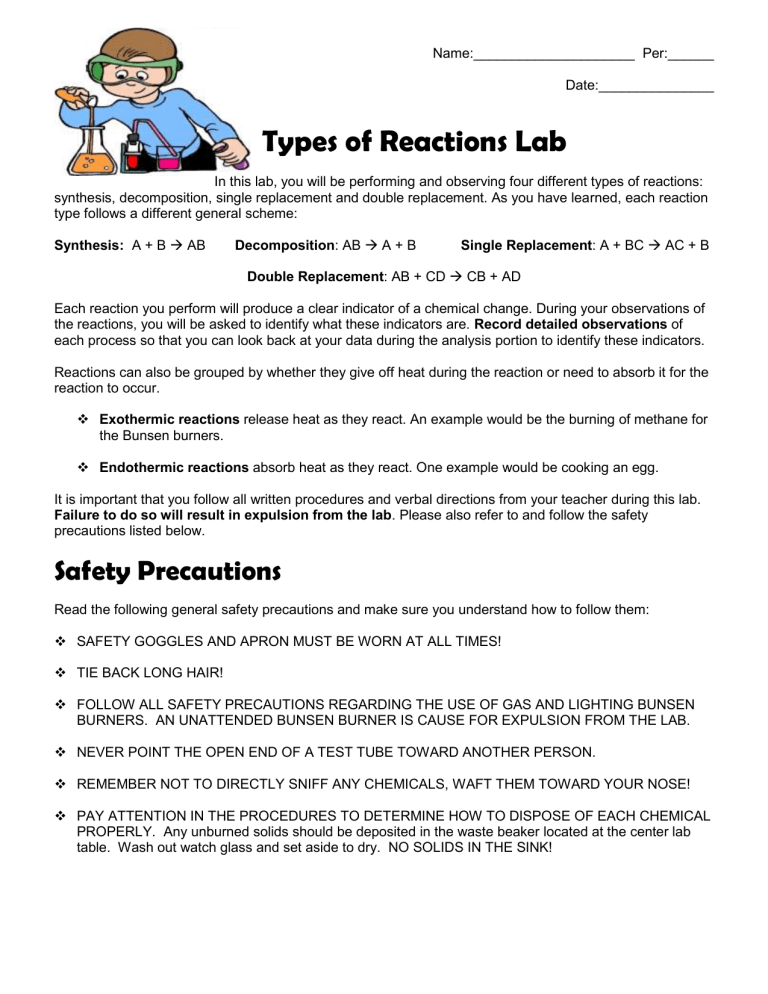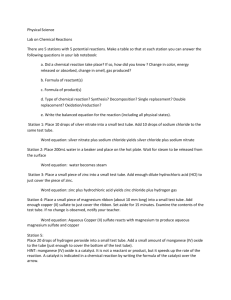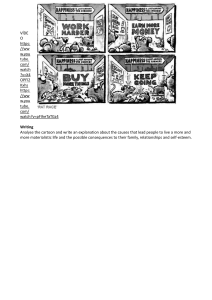
Name:_____________________ Per:______ Date:_______________ Types of Reactions Lab In this lab, you will be performing and observing four different types of reactions: synthesis, decomposition, single replacement and double replacement. As you have learned, each reaction type follows a different general scheme: Synthesis: A + B AB Decomposition: AB A + B Single Replacement: A + BC AC + B Double Replacement: AB + CD CB + AD Each reaction you perform will produce a clear indicator of a chemical change. During your observations of the reactions, you will be asked to identify what these indicators are. Record detailed observations of each process so that you can look back at your data during the analysis portion to identify these indicators. Reactions can also be grouped by whether they give off heat during the reaction or need to absorb it for the reaction to occur. Exothermic reactions release heat as they react. An example would be the burning of methane for the Bunsen burners. Endothermic reactions absorb heat as they react. One example would be cooking an egg. It is important that you follow all written procedures and verbal directions from your teacher during this lab. Failure to do so will result in expulsion from the lab. Please also refer to and follow the safety precautions listed below. Safety Precautions Read the following general safety precautions and make sure you understand how to follow them: SAFETY GOGGLES AND APRON MUST BE WORN AT ALL TIMES! TIE BACK LONG HAIR! FOLLOW ALL SAFETY PRECAUTIONS REGARDING THE USE OF GAS AND LIGHTING BUNSEN BURNERS. AN UNATTENDED BUNSEN BURNER IS CAUSE FOR EXPULSION FROM THE LAB. NEVER POINT THE OPEN END OF A TEST TUBE TOWARD ANOTHER PERSON. REMEMBER NOT TO DIRECTLY SNIFF ANY CHEMICALS, WAFT THEM TOWARD YOUR NOSE! PAY ATTENTION IN THE PROCEDURES TO DETERMINE HOW TO DISPOSE OF EACH CHEMICAL PROPERLY. Any unburned solids should be deposited in the waste beaker located at the center lab table. Wash out watch glass and set aside to dry. NO SOLIDS IN THE SINK! Procedure Station 1: SYNTHESIS Magnesium metal reacts with oxygen gas when heated to form magnesium oxide. 1. Write a balanced equation for the reaction given above: __________________________________________________________________ 2. Perform the Chemical Reaction: a. Obtain a piece of magnesium ribbon. b. Place a watch glass near your experimental set-up. Light the Bunsen burner. c. Grasp the magnesium ribbon with forceps or crucible tongs. Hold the ribbon in the top part of the flame for 5 to 15 seconds until it begins reacting. d. Once ribbon is brightly lit, DO NOT LOOK DIRECTLY AT THE FLAME. After the reaction is completed, carefully place the ribbon in the watch glass located nearby. 3. Clean up: Once it cools, throw the remaining magnesium in the trash. Wash the evaporating dish and the forceps/tongs with water. Dry and leave equipment for the next group. Initial Appearance of Magnesium Qualitative Observations During Reaction Final Appearance of Reaction Product Station 2: DECOMPOSITION Copper (II) carbonate decomposes into copper (II) oxide and carbon dioxide gas when heated. 1. Write a balanced equation for the reaction given above: __________________________________________________________________ 2. Perform the Chemical Reaction: a. Place 1 scoopula of copper (II) carbonate in a clean, dry test tube. b. Light the Bunsen burner. c. Using a test tube holder, hold the test tube over the top portion of the flame. Remembering how we heat test tubes (angled away from people toward the wall), heat the test tube and its contents until it completely changes color. d. Remove flame from underneath the test tube. 3. Conduct a flame test for a gas: Light a splint. Insert splint (but don’t let go of it) into mouth of test tube. Notice what happens when splint is inserted. Do not drop the hot splint into the test tube. Set aside the splint for later use. 4. Clean up: Using the test tube holder to hold the hot test tube, pour the remaining powder into the waste bin at your station. Initial Appearance of Copper (II) Carbonate Qualitative Observations During Reaction Final Appearance of Reaction Products Station 3: SINGLE REPLACEMENT #1 Hydrogen gas and zinc chloride are produced when zinc metal reacts with hydrochloric acid. 1. Write a balanced equation for the reaction given above: __________________________________________________________________ 2. Perform the Chemical Reaction: a. In a clean test tube, carefully dispense approximately 30 drops of 4M HCl. CAUTION: HANDLE ACIDS WITH GREAT CARE. DON’T INHALE AN ACID DIRECTLY AT ANY TIME! b. Make sure the test tube with the acid is in the test tube rack. c. Obtain a piece of zinc (using forceps, NOT YOUR FINGERS). Drop the zinc metal into the acid in the test tube. Quickly place an inverted test tube (holding it with your hand) over the test tube with Zn and HCl in it. Hold the tube in place for at least one minute. 3. Conduct a flame test for a gas: Light a splint. Slide apart the two test tubes and QUICKLY insert lighted splint into the bottom test tube. Record your observations. Set aside wood splint. 4. Clean-up: Pour the products into the waste container and then wash the test tube with soap and water. Turn it upside down on the test tube rack to dry. Initial Appearance of HCl and Zinc Qualitative Observations During Reaction Final Appearance of Reaction Products Station 4: SINGLE REPLACEMENT #2 When zinc metal reacts with aqueous copper (II) nitrate, copper metal and aqueous zinc nitrate are produced. 1. Write a balanced equation for the reaction given above: __________________________________________________________________ 2. Perform the Chemical Reaction: a. To a clean, dry test tube add approximately 30 drops (or 1 pipet) of copper (II) nitrate solution. b. Obtain a piece of zinc and drop the zinc metal into the copper (II) nitrate in the test tube. 3. Clean-up: Pour the products into the waste container and then wash the test tube with soap and water. Turn it upside down on the test tube rack to dry. Initial Appearance of Copper (II) Nitrate and Zinc Qualitative Observations During Reaction Final Appearance of Reaction Products Station 5: DOUBLE REPLACEMENT #1 Aqueous zinc nitrate and aqueous sodium phosphate react to produce solid zinc phosphate and aqueous sodium nitrate. 1. Write a balanced equation for the reaction given above: __________________________________________________________________ 2. Perform the Chemical Reaction: a. To a clean, dry well plate add 5 drops of zinc nitrate to one well. b. Add 5 drops of sodium phosphate to that same well. 3. Clean-up: Wash the well plate with soap and water. Dry it with a paper towel for the next group. Initial Appearance of Zinc Nitrate & Sodium Phosphate Qualitative Observations During Reaction Final Appearance of Reaction Products Station 6: DOUBLE REPLACEMENT #2 When aqueous iron (II) chloride and aqueous sodium carbonate are mixed, they react to form solid iron (II) carbonate and aqueous sodium chloride. 1. Write a balanced equation for the reaction given above: __________________________________________________________________ 2. Perform the Chemical Reaction: a. To a clean, dry well plate add 5 drops of iron (II) chloride in one well. b. Add 5 drops of sodium carbonate to that same well. 3. Clean-up: Wash the well plate with soap and water. Dry it with a paper towel for the next group. Initial Appearance of Iron (II) Chloride & Sodium Carbonate Qualitative Observations During Reaction Final Appearance of Reaction Products Analysis Write in COMPLETE SENTENCES! 1. What indicator(s) of a chemical change did you observe at: a. Station 1: Synthesis? _____________________________________________ b. Station 2: Decomposition? _____________________________________ c. Station 3: Single Replacement? _____________________________________ d. Station 4: Single Replacement? _____________________________________ e. Stations 5 & 6: Double Replacement? ________________________________ 2. You conducted two flame tests – at Stations 2 and 3. a. What gas was produced at Station 2? How did you conclude this from your flame test? _____________________________________________________________________ _____________________________________________________________________ b. What gas was produced at Station 3? How did you conclude this from your flame test? _____________________________________________________________________ _____________________________________________________________________ 3. Based on your observations and equation from Station 4, explain why the color of your solution changed during the reaction. _____________________________________________________________________ _____________________________________________________________________ 4. Aqueous silver nitrate reacts with aqueous potassium iodide. a. What type of reaction do you think takes place? _____________________________________________________________________ b. What do you think the product(s) might be? _____________________________________________________________________ c. Write a balanced chemical equation for the reaction, using your answers from 4a-b. _____________________________________________________________________ d. What indicator of a chemical change would you expect to see as proof that a reaction is taking place? _____________________________________________________________________






